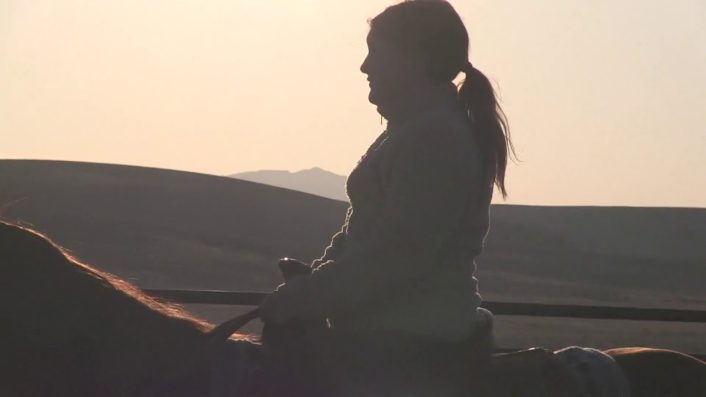Handing Over the Reins

Wilson calves move from one dedicated farm family to another.
October finds six semi-loads of the Wilsons’ Salers-Angus range calves winding through Wyoming mountains, over the pancake-flat Plains of eastern Colorado and past the looming wind turbines
standing sentinel over the Kansas Plains. Lush new digs in the vibrant green wheat pastures at Knight Feedyard in Lyons, Kansas, await the calves at the end of their journey.
It’s a well-trodden path. For nearly 10 years, Jim and Terry Wilson have taken calves they nurtured from their first wobbly steps on the rugged range at the V Ranch in Thermopolis, Wyoming, and delivered them into the care of another family who’ve dedicated their lives to tending livestock. The Knight family has decades of experience and a strong commitment to producing premium beef, which leads to a carefully managed and comfortable stay for the Wilsons’ calves with their new owners.
“That’s what I like to see as a cattle feeder,” beams Kenny Knight as he looks out at a pen of shiny Angus steers lounging peacefully in the unseasonably warm December sun. “Those cattle are happy, healthy, calm and gaining weight.”
Happy, healthy and calm are goals from the moment the calves arrive at the feedyard and backgrounding operation, which Kenny operates with his son, Mark. Calves are unloaded as quietly as
possible. There are no hotshots, no excessive whooping and hollering—just cattle shuffling off a truck into pens filled with a fluffy, welcoming bed of fresh straw.
“My son, Mark, started putting out bedding straw for all the new cattle coming in,” Kenny says. ‘It seems to make the cattle calm, like they feel a little bit at home. They’ll lay on it even if it’s 100 degrees outside.”
Easy living
Comfortable, healthy cattle are profitable cattle, making it an easy choice for the Knights to provide them with all they need to be both content and productive. The Knights follow the research-based recommendations of the Beef Quality Assurance program, a nationally-organized program outlining livestock husbandry techniques for delivering a healthy, safe beef product. Among those recommendations are health protocols and calm handling recommendations.
When better quality cows leave the farm and reach the marketplace, the producer, packer and consumer all benefit. –Beef Quality Assurance website “We use our own semis to get the calves, and all our drivers have been BQA trained. They don’t use hotshots, know how to handle the cattle and check them often,” Mark says. “We want it to be a peaceful process, so the cattle will be calmer and adjust to their new home faster.”
While steers are happily soaking up the sunshine, the cattle feeder is often found pacing the confines of his office fretting. Worry about how to stay afloat has resulted in much pacing and more than a few ulcers in the industry.
Cattle feeding is a tough business with staggering variability. Profit potential from year to year depends on the market price of the cattle coming in, often highly volatile market prices of feed and even more variability in the price they get for the final product. That’s not to mention impacts of weather and health during the feeding process. It’s unfortunate that despite best efforts, an entire year of work and worry may still result in a bright red number in the profits and losses column. Longevity in the business is the mark of a family capable of navigating the pitfalls and delivering a quality product year after year.
The Knights have proven their mettle, racking up 46 years of feeding cattle. Kenny started out farming and expanded into cattle feeding with Mark in 1972. Their family operation now includes a 13,000-head feedlot, 6,000 acres of wheat grazing with 10,000 total cropland acres, a 500-head Angus cow/calf herd in the Flint Hills and the Bar K Bar Trucking Firm.
“Our various operations help offset the cost of each other and keep us more profitable and more in control of our situation,” Mark says. Their tactics have kept them in the cattle feeding business while many other similarly sized feedlots have permanently closed their gates.
Part of their success stems from purchasing, stewarding and delivering quality cattle. Cattle they’ve come to know well by continually returning to trusted ranch families, like the Wilsons, to fill their pens. They take in calves already on the path to producing Prime beef and remove any hurdles.
“The Wyoming cattle are easier to predict and project so there aren’t any surprises during feeding or on the rail,” Mark says. There are some good surprises. Kenny noted one year he brought in 2,600 calves from trusted ranches in Wyoming. Of that group they lost only four head. That’s a 0.15 percent death loss. With unknown groups of cattle, a 2 percent death loss is considered normal.
“[The Wyoming cattle’s] health is generally good and their carcass performance is always excellent,” Mark says. “If you find good cattle from a responsible ranch you’ll generally do better than buying cattle out of the sale barn.”



